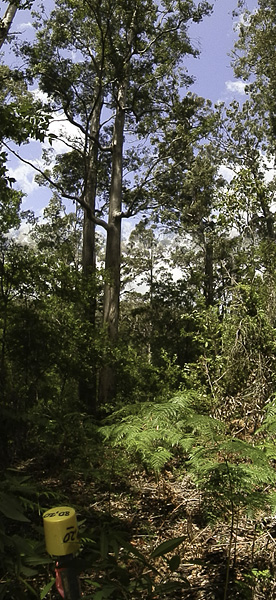A corner post marks the edge of a plot in a forest of tall (60m+) karri (Eucalyptus diversicolor) in the Warren region of Western Australia (Photo by Sam Wood)
Among the difficulties of understanding how forests might thrive, struggle or die because of climate change is teasing these changes apart from the usual ones that occur in complex communities of plants.
So, what do you do when you’re forest ecologist David Bowman and want to distinguish the wood from the trees?
You and the team at AusPlots Forests establish a complex of forest plots that will allow scientists to take an intricate set of measurements for decades, or longer, to gauge changes in the ways forests respond to climate change. AusPlots Forests is part of the network of research facilities that make up the Terrestrial Ecosystem Research Network (TERN).
David Bowman, the Professor of Environmental Change Biology in the School of Plant Science at the University of Tasmania, said it was far from simple making interpretations from the information they will collect.
‘It’s difficult to work out, even theoretically. One reason is to do with the intricacy of the interactions and the number of variables at work. Another relates to interpreting growth measurements: smaller trees grow faster than bigger trees, so you need large samples with a variation of tree sizes and species,’ David says.
‘We need to measure the right variables in the right way so that people can have confidence in any inferences we draw from the data we collect.
The benefit of AusPlots Forests’s involvement in the project is the range of plots David and other researchers have access to. They will study tall eucalypts – and the first set of plots has already been established in messmate (Eucalyptus obliqua) forest in Tasmania and karri (Eucalyptus diversicolor) forest in south-west Western Australia. A second set of plots will be established progressively in the tall forests of Victoria, New South Wales and Queensland this year and next year.
‘To understand the small ways in which forest communities change as the climate gets wetter or drier, as temperatures increase or decrease, we need plots that lie along gradients of slowly changing growing conditions. AusPlots Forests can do this by creating a plot network that can act as a proxy for the whole continent. With the information we collect from the plots, we should be able to make confident predictions about how eucalypt forests will respond to climate change, and demonstrate that this is not due to the “background noise” of inherent variation that occurs in natural forests as the plants communities develop, and the trees grow and mature,’ David says.
‘Once we have dependable predictions, it will help the whole Australian community to decide how to adapt livelihoods and industries to accommodate ecosystem changes. This will be borne out in government policy and how we manage these systems. At the moment, we have little idea how these forests are growing in response to all the changes in the environment.’
The AusPlots Forests team, led by Dr Sam Wood, a postdoctoral fellow at the University of Tasmania, is setting up at least 40 one-hectare plots, capturing data from some pre-existing plots.
At each plot, forest ecologists will regularly measure attributes of tree growth, species composition, canopy cover, and mortality. These data are important because they help scientists understand the carbon balance of forests and the effects of variations in the climate on forest productivity and biodiversity.
The data will be made available free through the Australian Ecological Knowledge and Observation System (ÆKOS), the data portal of another TERN facility, Eco-informatics. It will tie in with international forest-monitoring systems such as RAINFOR, thereby becoming part of the international discussion on climate change.
Come along to David’s presentation at the 2013 TERN Science Symposium to find out more about this project or AusPlots Forests.
Published in TERN e-Newsletter January 2013







